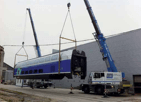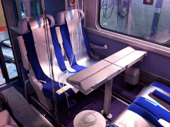Air conditioning tests on a RGV2N2 trailer car (R8)
This study case was written as part of a test campaign for ALSTOM Transport.
DESCRIPTION
As part of the process of finalising the design of its new RGV 2N2 rolling stock, ALSTOM Transport approached EURAILTEST’s Thermal and Airflow Test Chamber (CETA) with the request that it carry out type tests on an R8 trailer car over the period from 10 November to 22
December 2011.
SNCF is increasingly aware of the importance of offering its customers the extra comfort of well-controlled, well-adjusted air-conditioning systems on its trains. The CETA test chamber is therefore regularly asked to validate the temperature control parameters of railway vehicles
by testing their air-conditioning systems in accordance with European standards EN 13129 1 and 2.
In its 30-metre long test chamber it can simulate outside climatic conditions (temperature, relative humidity, sunshine) and heat levels within the coach itself (latent and sensible heat from human bodies).

Transfer of the RGV2N2 trailer
The RGV2N2 trailer was taken by truck from ALSTOM Transport’s premises in La Rochelle to the Technicentre at Romilly sur Seine, where the CETA facilities are located. A crane was used to transfer the coach from truck to rail (see photo left).

Installation of the measuring chain
For the first two days, the CETA laboratory and ALTSOM Transport teams worked hand-in-hand to equip the coach with the instruments required by the EN 13129 1 and 2 standards and by the specifications previously provided by ALSTOM Transport.
Some 250 sensors were fitted in different positions:
– at head height for a person standing up (1.70 m),
– at head height for a person sitting down (1.10 m),
– at knee height (0.40 m)
– at foot height (0.10 m)
The physical presence of individuals in the coach was simulated by means of 10 air humidifiers and 92 heating mats placed over the two floors of the double-decker RGV2N2.

Test procedures
The engineers and technicians present at the tests monitored and took real-time recordings of the information delivered by the sensors installed on the coach: fresh-recycled-extracted air flows, airflow pressure, electrical characteristics (power, current and consumption) of the ventilator and compressor motors, temperatures and humidity, etc.
CETA simulated:
– temperature from -20°C to +50°C
– sunshine up to 800 W/m²
– relative humidity from 40 to 80%
– ridership (92 passengers)
Tests were performed in three stages:
Finalisation tests: period during which the climatic chamber was made available to MERAK, the firm responsible for installing the air-conditioning
units and for setting the temperature control parameters
Type tests: time required to validated the thermal comfort parameters of the vehicle
Fluids tests: quantification of the fluids lost by the air-conditioning units and validation of the response of the corresponding automatic control system
The opportunity was also taken to test and validate the WC units and the efficiency of their anti-freeze systems for outside temperature of up to -10°C.On 26 December, the trailer set out on its return journey by road to the ALTSOM facility.





 FR
FR